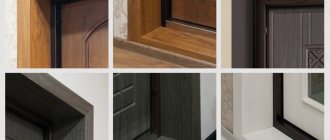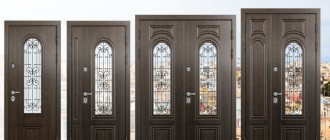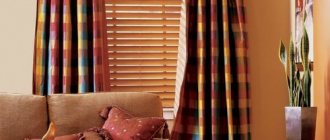It often happens that when purchasing a secondary home, the interior or entrance doors in the apartment leave much to be desired. For example, the color may not suit the overall interior at all, while the structure as a whole is intact. And therefore there is a desire to change the doors. But why change when they are still good, in acceptable condition and can hang around for decades? There is a solution: you just need to paint the door.
Scheme of a veneered door with a varnish coating.
Troubles will not appear if you take into account the material that forms the basis of the structure and the degree of wear of the surfaces.
How to paint a door made of different materials? Painting rules differ in each situation. Let's look at them in order.
Veneered doors
To clarify the picture, let’s clarify what veneered doors are. Veneered interior doors can be externally confused with products made from natural solid wood, although the former are much lighter and more functional. Why? For an answer, you can turn to the specifics of the technology for manufacturing veneer doors.
Veneer is a rather capricious material and is nothing more than the thinnest cut of valuable tree species, intended for decorative finishing of the surfaces of the door frame and door leaf. A veneered door conveys the texture and natural shade of natural wood.
The most commonly used technique is to connect veneer to a panel structure. An MDF (modified wood) panel is glued to a blank of wood blocks (mostly coniferous). This frame is responsible for the necessary geometry of the door, making it more resistant to the negative effects of humidity and temperature fluctuations. Following a special technology, a veneer covering is glued onto the MDF board. That is, the hot pressing method is used.
Sequence of painting the door leaf.
The gluing of the finish to the base surface is carried out thanks to the resins released from the wood when heated. Synthetic products are not used. To ensure a glossy shine, the structure is coated with the desired shade of varnish in several layers. He is responsible for the final color of the product. It is important to note that veneered models, like those made from solid wood, within the same delivery from the manufacturer have significant differences in color from each other.
The reason here lies in the uniqueness of the pattern of the wood cut, as well as in its ability to refract light. Among other things, the panel is finished with more than one sheet of veneer, which complicates the task of harmonizing the pattern of stripes. Each model is unique and original. You can choose several products that are similar in color, but they will still be different in texture and design.
Sometimes the internal space of the structure is filled with cardboard honeycombs, which makes it even lighter. This factor is important for an interior door: you won’t have to make any effort when opening and closing it.
There are models that are covered not with a cut from wood, but with films made using a special technology with a 2D effect (artificial veneer), imitating the texture and pattern of wood. Such doors are difficult to distinguish externally from veneered interior doors. Their advantage, compared to the latter, lies in their higher moisture resistance.
Which paint to choose
First, decide what paints are used to apply to the door:
Alkyd enamels. This is the most affordable option. Film strength is average. The advantages include a large range of colors and compatibility with MDF, fiberboard and wood. The main disadvantage is the long drying time and the characteristic pungent odor. Among materials of this type there are a large number of glossy coatings.
- Acrylic enamels. This type of paint is a water dispersion of acrylates. The main advantage over other compositions is the absence of odor and quick drying. In addition, the color palette, represented by hundreds of colors, allows you to create unique shades yourself. To protect the surface, it is additionally coated with parquet transparent varnish.
- Oil-based tinting paints are great for transforming interior and entrance doors. Absorbing into the wood texture they give it a unique shade. The only condition for their use is wood, without any coating.
Variety of paints and varnishes
Nitroenamels. They dry quickly, but at the same time a volatile, caustic solvent evaporates, which can cause ill health and even poisoning
If you take precautions and use personal protective equipment when working, then this option deserves attention. After complete evaporation of the solvent, the coating becomes safe
It is considered a high-quality and fast method of painting. Colored varnishes, glazes. These materials are used for painting varnished door panels. Used in cases where there are no significant cracks or chips on the base. To fully restore the varnished surface, the old varnish must be removed, or you can refuse to re-varnish and paint over the interior doors after puttying.
Caring for a veneer door
Tools for painting doors.
An interior door will retain its original appearance for a long time only if it is used carefully and carefully. It is not recommended to use abrasive products that can leave deep scratches to clean door surfaces.
Liquid-based cleaners consist of chemically active components that come into contact with the varnish. The use of the latter can leave unsightly bald spots on the varnish.
How to paint a veneer door?
The first step is to resolve the dilemma of whether to leave the solid wood color or completely change the color. The choice of door restoration method is influenced by factors such as the magnitude of deformations.
When choosing the first option and in the presence of small scratches and defects, they make do with varnishing, after which the door is thoroughly rubbed with polish. It is possible to eliminate small scratches locally by applying colored varnish of the appropriate shade.
Sometimes, after purchasing a model of interior door that you like, you discover that its color is not exactly what you expected and it does not match the color scheme of the interior. What can be done in this case? A completely new (not used) canvas can be varnished in a different tone without removing the previous layer of varnish. Stable flooring works great for this purpose, but not furniture!
The previous layer of varnish is removed using fine-grained sandpaper or a special remover. It is unacceptable to use a grinding turbine here: due to the high-speed grinding, dents may occur.
Correct distribution of paint over the roller.
If you plan to change the color of the door completely (damage is visible from a long distance with the naked eye), then you should prepare for additional types of work. The sequence of actions will consist of surface preparation and painting. Manipulations on natural veneer due to its insignificant thickness should be carried out with extreme caution. In the absence of appropriate skills, it is more advisable to entrust all the work to professionals.
The surface is prepared by cleaning dust and contaminated areas, removing the layer of the previous varnished coating.
The first step is to cover up all the unevenness with a special primer. A veneer door can be decorated with polyurethane, glyphthalic or water-based paint. Nitro paints cannot be used for veneer - matte spots may appear on it. The best option for painting veneer doors is using water-based paints.
To paint the door, you should wait until the primer is completely dry.
Painting faux veneer doors is also possible from a theoretical point of view. However, it is unlikely that you will be able to achieve the desired result, since it is very difficult to choose paint that does not roll off a smooth surface and stay on it. And if you prime the canvas, the natural effect of natural wood will be lost. Carrying out high-quality repairs on artificial veneer doors is possible in a slightly different way. This circumstance is important to take into account if this particular model is purchased (or received along with the apartment).
Rules for painting panel and panel doors.
Let us emphasize once again: before painting a veneer door, you should decide how urgent it is to change the appearance of the product and which product is better to use - varnish or paint.
By changing the composition of the surface layer using chemical dyes, the environmental friendliness of the structure can be disrupted.
Consulting with a specialist in veneer doors will help you decide on this issue in many ways.
Preparing the door covering
Well, let's figure it out further, how to paint a door correctly? Preparatory work is carried out according to the following scheme:
- Remove all old coating, even primer and putty, until the wood itself remains. For this work, you can use a grinder, a hair dryer, or special cleaning compounds.
- Then you need to sand the surface, remove any defects, sand off small paint residues, and degrease. This work cannot be done without a sander, which is best connected to a vacuum cleaner. If you don’t have such a device, you can get by with medium-grain sandpaper.
Plastering a door
- When you have completely managed to sand the canvas and prime it, you can move on to puttying large flaws. If you plan to use varnish as a finishing coat, it is better to use a special composition for wood. If the decorative dye is not transparent, you don’t have to worry about the color of the putty. Don't forget about the gaps at the walls and baseboards!
- After puttying, after waiting the time specified by the manufacturer of the mixture, you need to sand again, masking the abrasions. You can immediately use a medium-grained cloth, and then finish with a fine-abrasive one.
If the doors under the old finishing materials have darkened, and you would like to simply open them with varnish, preserving the structure and pattern of the wood, problem areas can be lightened. To do this, you can prepare a simple bleach with your own hands: mix bleach with water in a ratio of 1:3. When the surface is completely processed, wiped with a rag and dried (so that the paint does not begin to swell), you can begin directly painting the door.
Painting paneled doors
Today, paneled doors can be painted in one of two ways.
Method one. First, paint is applied to the ends. Then carefully clean the damaged areas of the panel. A new layer of primer is applied to the cleaned surface. And paint is already applied to the primer, twice. This method is suitable for painting door surfaces with smooth surfaces.
Such doors are coated with varnish or stain in strict accordance with the stated requirements from the manufacturer.
Method two. Tinting the door panel and frame is used when the surface has a wood texture. To hide wood imperfections, you can use a white shellac primer. Stain will help achieve the desired shade. When painting any surface, you should use only high-quality brushes and materials.
Surface preparation
The quality of painting depends on proper preparation of the product. The process consists of the following steps:
- One of the selected methods removes all old paint from the door block. It is more convenient to carry out the work on the sash removed from its hinges and laid horizontally. All accessories are removed from the canvas, since protruding elements interfere with operation, and during cleaning they can be damaged.
- The next stage is sanding. Designed to remove minor defects, paint residues, and burrs. Sanding can be done with sandpaper wrapped around a wooden block. Working with a grinder will go faster. A vacuum cleaner is connected to the dust removal tool.
- Before plastering a wooden surface, determine the type of paint and varnish material used. For transparent varnishes, choose a composition that imitates the color of wood. If wooden doors are to be painted with opaque enamel, putty can be used in any shade.
- After the putty has dried, final sanding is performed. First comes the rough grouting with a medium-grain abrasive. Finishing is carried out with fine grain.
- After removing the paint, dark spots may remain on the wood. If you want to cover an old wooden door with clear varnish, try bleaching the problem areas with a mixture of chlorine and water in a ratio of 1:3.
Painting laminated doors
The paint adheres perfectly to a smooth laminated surface, but it will not last long. Therefore, the first step is to remove the top layer of impregnated varnish using a sanding machine and, if necessary, zero sandpaper.
We should not forget that directly under the protective layer there is a particle board, which will easily begin to crumble if the treatment is carried out at a sufficiently deep distance. The prepared surface is thoroughly wiped with a solvent and a layer of primer-antiseptic mixture is applied. Wait some time for the protective layer to dry and apply paint.
Impregnation of the door surface.
You can purchase any paint, since particle board is unpretentious in terms of coatings applied to it.
The paint is distributed over the surface using a spray gun or a roller with velor pile. After the 1st layer has dried, apply the second. A day later, the painted door is varnished with a transparent composition, which will act as protection during operation.
Useful tips from the experts
To eliminate defects and errors when varnishing an interior door, follow the recommendations of the craftsmen:
- Use masking or paper tape. Wrap the product around door handles and other fittings. This will protect the elements from varnish and construction mixtures. Regular tape is prohibited. It will leave traces that are then impossible to get rid of.
- Choose mixtures and varnishes from the same manufacturer. Don’t forget about a trial application of paintwork.
- It is better to get rid of the old protective layer. This has a positive effect on the final appearance of the door and will extend its service life.
- Don't forget about safety precautions. Perform work wearing protective gloves. If your skin becomes irritated, wear protective clothing.
- Ventilate the room.
- After finishing work, allow the door to dry thoroughly: do not touch or load.
On doors made of birch, oak and pine, varnish is applied generously so that the surface is thoroughly saturated. Remove any remaining paint with a brush and acetone. It is better to protect the floor surface and other interior elements with rags, tape or paper to save time on cleaning the room.
It's easy to varnish interior doors. The process does not require a person to have deep knowledge in the painting field. It is enough to arm yourself with tools, choose the right building mixtures and paints, and properly prepare the work surface. Advice from the experts will help you approach each stage more professionally.
Painting MDF doors
You can safely paint an MDF door with compositions that contain 2 components: varnish and a tinting agent (for example, “Lakobeits”). At the same time, the structure of the product will be preserved, and external neatness will, of course, be added.
The consistency of Lakobeits is liquid, which allows the composition to penetrate deeply into the porous surface of MDF, fill it, forming a uniform and thin layer. The latter is an excellent protection against moisture.
It is very convenient that the varnish and tonic are mixed and applied at the same time. There is no need to apply each layer in turn, waiting for the previous layer to dry.
You can paint with a brush, then no special skills are required from an amateur painter. The main thing is to make sure there are no leaks.
When painting a door with a pattern with a roller or spray gun, it is difficult to achieve the required evenness of the layer. Only a professional should paint in such a situation.
It is quite simple to prepare MDF doors for painting: they are wiped with a damp cloth or washcloth to remove excess particles.
Required tools and materials
Tools for painting veneered doors
To paint a veneered door with high quality, there is no need to purchase expensive equipment. In most cases, everything you need can be found in your home pantry.
To work you will need:
- rubber spatula;
- stationery knife;
- sandpaper;
- wash;
- brush;
- roller;
- spray gun or spray gun;
- square;
- primer;
- final paint coating.
The specifics of the upcoming activity should be taken into account. It must be performed in protective glasses, gloves, a respirator, and in conditions of high-quality ventilation of the room.











